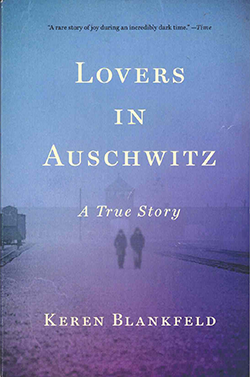Lovers in Auschwitz: A True Story by Keren Blankfeld; New York: Back Bay Books, an imprint of Little, Brown and Company, (c) 2024; ISBN 9780316-564786; 322 pages plus appendices, $19.99.

 SAN DIEGO — David Wisnia from Poland was a prisoner at the Auschwitz-Birkenau concentration camp complex; Likewise, Helen Zipora “Zippy” Spitzer from Slovakia was also a prisoner. But neither of them was an ordinary prisoner; by virtue of wits and luck, each of them had been elevated to favored positions in the concentration camps’ hierarchy.
SAN DIEGO — David Wisnia from Poland was a prisoner at the Auschwitz-Birkenau concentration camp complex; Likewise, Helen Zipora “Zippy” Spitzer from Slovakia was also a prisoner. But neither of them was an ordinary prisoner; by virtue of wits and luck, each of them had been elevated to favored positions in the concentration camps’ hierarchy.
Zippy, a graphic artist, was employed in the administrative section of the camp. Hyper-organized, she soon was entrusted with keeping the grisly records of murder: how many inmates were delivered to Auschwitz, how many were gassed; how many died of other diseases; the population of each bloc. With the position, she got many perks: more food allowances, the right to wear civilian clothes, and the clandestine ability to change the records. She often substituted the numbers of those already dead for living prisoners whom the Nazi overlords intended for the gas chambers. Because prisoners were identified by number, not by name, this was relatively easy to do. For the Nazis, the numbers, and the people they represented, were interchangeable.
David, a young muscular man with an operatic singing voice, was awarded a coveted spot in the camp’s delousing facility–where the temperatures were so warm that the facility was nicknamed the “sauna.” Here the clothes of arriving prisoners were steam cleaned, packaged, and sent back to Germany for the use of the Nazi regime and the civilian population.
Zippy was so trusted that during the day she had free run of the men’s and women’s camps. Even the guards respected the fact that she was liked by the camp’s administrators, so they did not harry her. When she spotted David working in the sauna, she felt an attraction and after months of build up — a smile here, a lingering look there — she decided to act upon it. In a compartment where collected clothes were stacked as high as walls, David and Zippy made love once a month, in conformance with her canvassing schedule.
They were separated at the time of liberation, having previously named a place where they should meet in the post-war. But the plans went awry, and the lovers did not have a reunion until many years later.
Blankfeld follows the lives of David and Zippy before, during, and after their incarceration in Auschwitz. While the title of the book focuses on their trysts, their sexual congress represents only a small and unusual portion of the well-researched history that personalizes the Holocaust. The title may attract readers who might otherwise be reluctant to read about the Holocaust.
The book makes passing mention of other noteworthy Auschwitz prisoners, including former ballerina and Hungarian gymnast Edith Eva Eger who was made to dance before Josef Mengele, the Nazi doctor who decided whether inmates would live or die. Eger, a psychologist and author in her late 90’s, now resides in San Diego County.
*
Donald H. Harrison is publisher and editor of San Diego Jewish World.
Thank you, Don, for reviewing this book. I look forward to reading it and seeing the Holocaust through a new perspective. I’m also delighted that your mention our local brilliant and loving “celebrity,” Dr Edie Eger.